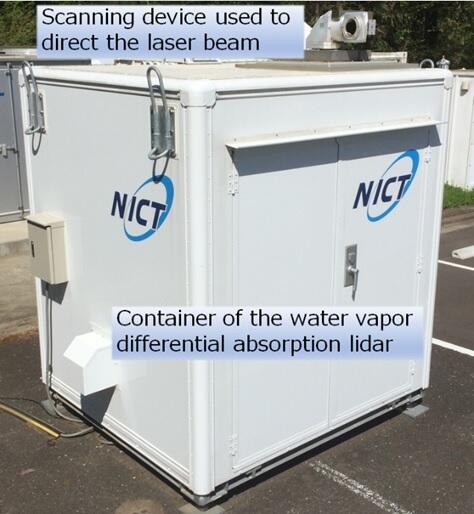The National Institute of Information and Communications Technology (NICT) announced that its Radio Research Institute has developed a "differential absorption LIDAR" that can simultaneously observe water vapor and wind in the atmosphere in all directions at both day and night. The device, developed using NICT's proprietary laser light wavelength locking technique, has demonstrated a technique for observing the amount of water vapor with an error of less than 10%. According to NICT, incorporating the observed values of water vapor and wind into numerical weather prediction models will greatly improve the accuracy of forecasting the locations of quasi-stationary band-shaped precipitation systems (Senjo-Kousuitai) that experience heavy rainfall. The results were published in the US scientific journal Optics Express on April 24th, 2023.

(provided by NICT)
Information on atmospheric water vapor and winds prior to the onset of heavy rainfall is important for improving the accuracy of forecasting the heavy rainfall. During the process of cumulonimbus cloud formation (which cause heavy rains) until the commencement of the rain, moist air masses near the ground are first collected by the wind and then lifted upwards by updrafts to form clouds. In strong updraft conditions, the air masses are lifted to higher altitudes, creating large amounts of raindrops. Heavy rain then occurs because the updrafts can no longer support the weight of large raindrops. In order to predict heavy rainfall, it is important to observe the amount of water vapor in the atmosphere and its flow.
However, the main water vapor measurement method currently available is the use of sensors installed at specific weather stations. However, these sensors can measure water vapor only at these observation points and are unsuitable for measuring its spatial distribution. A new technology is required that can measure the spatial distribution and flow of water vapor.
To meet this demand, NICT has developed a differential absorption LIDAR, a remote sensing technology that uses lasers to measure the spatial distribution of wind and water vapor. The water vapor differential absorption LIDAR developed by NICT uses infrared laser light with a wavelength of 2 microns (µm), which is relatively safe for the human eyes, and can be emitted in any direction.
The 2 µm wavelength range is less affected by solar background light (sunlight as background noise) than the other wavelength ranges used for LIDARs. The effect of solar background light is greatly suppressed by using a system that receives a narrow bandwidth of light. These technologies have enabled daytime and nighttime observations of water vapor and wind in the atmosphere.
Using NICT's unique wavelength locking technique, a comparison of the results obtained from the differential absorption LIDAR with those from radiosondes demonstrated good agreement between them during actual observations in summer (when water vapor content is high). This further supports that measurement error of 10% or less could be achieved, which is required for data assimilation into weather prediction models.
In horizontal observations, the water vapor and wind measurements obtained from the differential absorption LIDAR agreed with those from the surface meteorological sensors. Previous studies have shown that the assimilation of water vapor data into a numerical weather prediction model improves the accuracy of forecasting the Senjo-Kousuitai. In this case, simultaneous measuring of the wind was possible along with the acquisition of water vapor data. This means that assimilation of water vapor and wind data simultaneously is feasible, and it is expected that the prediction accuracy of the locations of the Senjo-Kousuitai can be further improved.
NICT will continue to develop high-power pulse lasers for high-precision and -frequency, and long-range observations of water vapor and wind. They will also verify the accuracy of the water vapor measurements of the differential absorption LIDAR using the developed lasers to improve the accuracy of weather forecasts. The development of an inexpensive system will be promoted for the spread of this water vapor differential absorption LIDAR into the society.
Journal Information
Publication: Optics Express
Title: Evaluation of a coherent 2-µm differential absorption lidar for water vapor and radial wind velocity measurements
DOI: 10.1364/OE.485608
This article has been translated by JST with permission from The Science News Ltd. (https://sci-news.co.jp/). Unauthorized reproduction of the article and photographs is prohibited.




